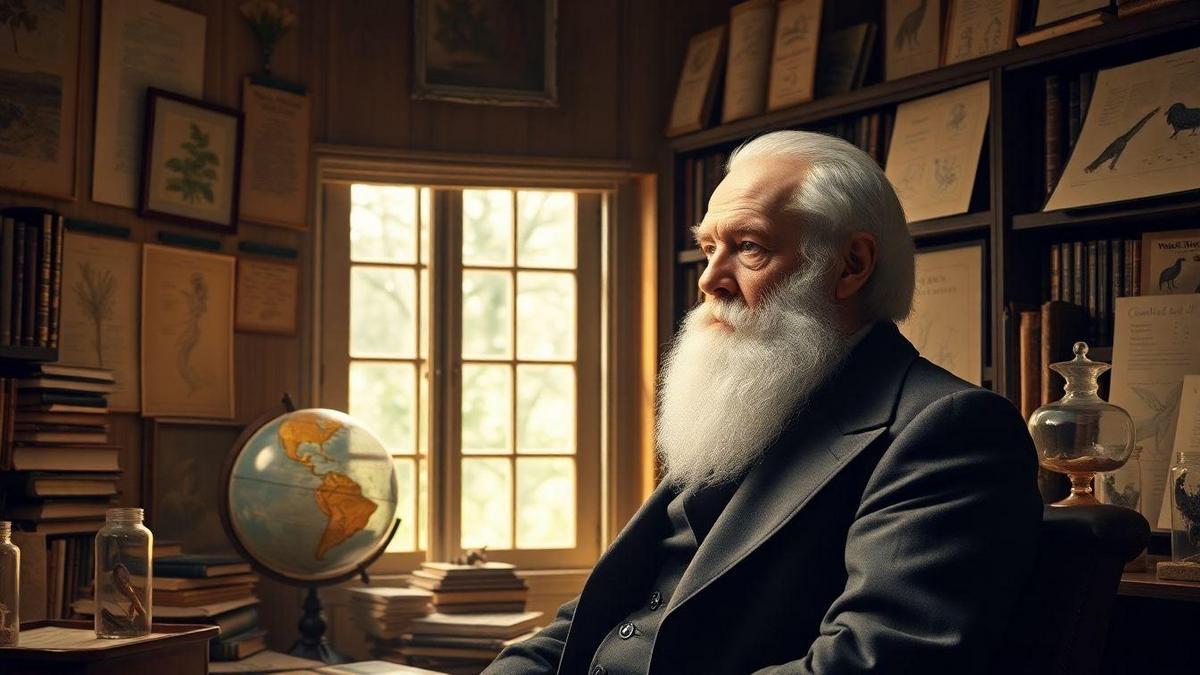Anúncios
The theory of evolution by Charles Darwin profoundly transformed our understanding of life on Earth. Published in 1859 in his work “On the Origin of Species,” this theory offered a new perspective on how species develop and adapt over time. By proposing that changes in species occur through natural selection, Darwin challenged previous ideas about the origin of life forms.
His legacy extends beyond biology, influencing areas such as psychology, sociology, and philosophy. Darwin’s theory not only unifies biology but also offers a comprehensive view of life’s diversity. The impact of his ideas continues to be a pillar for the development of modern science.
Anúncios

The Fundamentals of Darwin’s Theory
Darwin’s theory is based on the idea that species evolve over time. He proposed that living organisms vary from one another, and these variations can be passed down to subsequent generations. Genetic differences between individuals of a species are crucial for the evolutionary process.
Natural selection acts upon these variations, favoring individuals that possess characteristics that increase their chances of survival. These organisms are more likely to reproduce and pass on their traits to their offspring. Over time, this results in changes in the population and may lead to the emergence of new species.
Darwin also suggested that all living beings share a common ancestor. This revolutionary idea helped to unify different branches of biology, such as genetics, paleontology, and ecology. Understanding this common ancestor is essential for constructing the evolutionary history of life on Earth.
Natural selection is not an immediate process but rather a gradual one, occurring over many generations. The adaptation of species to their environment is therefore a dynamic and continuous process, driven by the interaction between living organisms and changes in their surroundings.
Natural Selection and the Evolution of Species
Natural selection is one of the central pillars of Darwin’s theory. It occurs when some organisms possess advantageous traits that increase their chances of survival and reproduction. These traits can be physical, such as skin color, or behavioral, such as feeding patterns.
Organisms with these advantages are more likely to reproduce and, therefore, pass their traits on to the next generation. Over time, the population of the species comes to have a higher concentration of these advantageous traits, resulting in adaptations to the environment.
It is important to highlight that natural selection is not a random process. While variations in individuals of a species occur by chance, natural selection acts in a non-random way, favoring characteristics that increase the chances of survival. Thus, the evolution of species becomes more directed and adapted to environmental conditions.
This process is responsible for the great diversity of life we observe on Earth. The adaptation of species to different environments has resulted in an impressive variety of life forms, with distinct characteristics that ensure their survival in specific niches.
The Importance of Charles Darwin and His Theory in Understanding Life on Earth

Charles Darwin is one of the most influential figures in the history of science. His seminal work, “On the Origin of Species,” published in 1859, revolutionized our understanding of life on Earth. The theory of evolution through natural selection proposed a new way of seeing the natural world, challenging traditional beliefs about creation and the diversity of species. Darwin’s importance extends beyond his impact on biology; his ideas also influenced fields such as psychology, sociology, and even philosophy. Darwin’s legacy continues to shape contemporary scientific thought and our understanding of life.
The theory that unifies the understanding of life on Earth provides a framework for understanding how species evolve over time, adapting to their environment. This adaptation is a continuous and dynamic process, resulting in a diversity of life forms that we observe today. The idea that all species share a common ancestor is a powerful notion that unites biology, paleontology, and genetics. Thus, the theory of evolution is fundamental to modern science, as it provides a cohesive explanation for the complexity of life and the interactions between living beings and their environment.
How the Principles of Natural Selection and Evolution Work
The principles of natural selection and evolution are based on a few fundamental assumptions. First, variation among individuals of a species is crucial. These variations can be subtle, like the color of a bird, or more obvious, such as the size of an animal. These differences can be inherited and, therefore, passed on to the next generation. Variation is the raw material upon which natural selection acts, allowing certain traits to become more prevalent over time.
Second, the struggle for survival is an essential aspect of natural selection. Organisms compete for limited resources, such as food, space, and mates for reproduction. Those that possess advantageous traits that help them survive and reproduce are more likely to pass these traits to the next generation. This process results in the continuous adaptation of species to their environment as conditions change over time.
Moreover, natural selection is not a random process. While variations occur by chance, natural selection favors characteristics that increase the chances of survival and reproduction. This means that, over many generations, species become increasingly adapted to their environment. This adaptability is one of the reasons why life on Earth is so diverse and complex.
Finally, evolution is not a linear process, but rather a web of branching paths. Species can diverge from a common ancestor, leading to the formation of new species over time. This process is known as speciation and is fundamental to understanding the biodiversity we observe today. The theory that unifies the understanding of life on Earth is, therefore, a story of change and adaptation, driven by natural selection.
Advantages of Understanding Darwin’s Theory of Evolution
Understanding Darwin’s theory of evolution brings numerous advantages, both for science and for society. First, this theory provides a solid foundation for modern biology. Evolution is a central concept that connects various areas of biology, such as genetics, ecology, and paleontology. This allows scientists to develop a deeper understanding of the mechanisms that govern life on Earth.
Second, the theory of evolution helps explain the diversity of species. By understanding how species adapt and evolve, we can appreciate the complexity of life and the interdependence between organisms. This understanding is essential for the conservation of biodiversity and the protection of ecosystems, which are vital for the health of the planet.
Additionally, Darwin’s theory has significant implications for medicine. Understanding evolution is crucial for the development of vaccines and treatments because pathogens also evolve. Knowing the principles of natural selection allows scientists to anticipate how viruses and bacteria might change, helping to create effective strategies to combat diseases.
Finally, Darwin’s theory promotes a more critical and scientific view of the world. By challenging dogmatic beliefs and encouraging empirical investigation, Darwin’s theory contributes to a more informed society that is open to learning. This mindset is crucial for addressing contemporary challenges such as climate change and biodiversity loss.
How Darwin’s Theory Influences Modern Science

The theory that unifies the understanding of life on Earth continues to influence modern science in several ways. First, it establishes a paradigm for scientific research. The idea that species evolve over time provides a framework that guides studies in biology, ecology, and genetics. This paradigm is crucial for formulating hypotheses and interpreting data, allowing scientists to make predictions about how organisms might respond to different environmental pressures.
Moreover, the theory of evolution has a significant impact on biotechnology. Knowledge of how organisms adapt and evolve is fundamental for developing new technologies and products. For example, genetic engineering benefits from the understanding of evolutionary mechanisms, allowing scientists to create genetically modified organisms that can resist pests or adapt to extreme climatic conditions.
Darwin’s theory also influences psychology and social sciences. Understanding human evolution provides insights into behavior, cognition, and social interactions. By analyzing how behavioral traits may have evolved, researchers can better understand human nature and social dynamics, contributing to fields such as evolutionary psychology and anthropology.
Finally, the theory of evolution is a powerful tool for scientific education. By teaching the principles of natural selection and evolution, educators can foster critical thinking and curiosity in students. This is particularly important in a world where misinformation and anti-intellectualism are on the rise. Understanding the theory that unifies the understanding of life on Earth helps form informed citizens who can actively engage in scientific and social debates.
Did You Enjoy Learning About Darwin’s Theory and Its Importance for Life?
Darwin’s theory and its fundamental principles are essential for our understanding of life on Earth. Understanding how evolution works and its implications is crucial not only for biology but also for society as a whole. Darwin’s work continues to inspire new research and shape contemporary scientific thought.
If you are interested in the theory that unifies the understanding of life on Earth and its applications, there is a world of knowledge waiting for you. Evolution is a fascinating story that reveals the complexity of life and the interconnectedness of all species. Explore more about this topic and discover how it can enrich your understanding of the world.
Frequently Asked Questions
Who was Charles Darwin?
Charles Darwin was an English scientist famous for his ideas on evolution. He studied how species change over time.
What is the theory of evolution?
It is the idea that all species evolved from common ancestors. The theory is fundamental to understanding the diversity of life on Earth.
How did Darwin’s theory change science?
Darwin’s theory challenged ancient beliefs. It helped explain how species adapt and survive in their environment.
Why does the theory unify the understanding of life?
It connects all forms of life. Understanding evolution helps you see how all species are related.
Where can I learn more about Charles Darwin and the theory unifying the understanding of life on Earth?
You can read books, watch documentaries, and explore educational websites. There is plenty of material available to deepen your knowledge!
